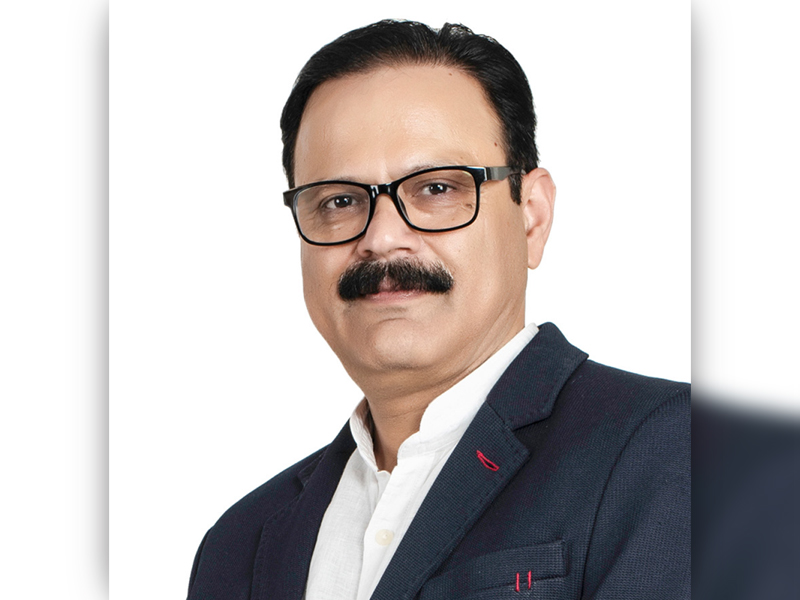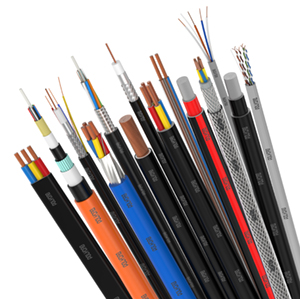‘’For LDC wires, we have our manufacturing plants in Halol and Nashik. We have installed machine lines with a manufacturing capacity of up to 30m per second.’’
Polycab is one of the largest manufacturers of wires and cables in India. The LDC (Light Duty Cables) department of Polycab handles a broad array of products such as building wires, industrial wires, communication cables, switchgears, pipes, and fittings. Integrating breakthrough engineering with a meticulous selection of raw materials, the company introduced the segment of ‘Green Wires’ that is in strict accordance with European standards in terms of environmental sustainability and cable safety. These wires are energy-efficient, recyclable, RoHS (Restriction of Hazardous Substances) and REACH compliant, in addition to having low smoke density and emitting fewer toxic gases in extreme fire situations.
In an interview with Wire & Cable India, Mr. Bhushan Sawhney, Executive President & CBO Sales (LDC), Polycab India Ltd., takes us through the product range in the LDC segment along with its applications, the manufacturing capabilities of the segment, the making of Polycab’s Green Wires and the trends in the Indian wire & cable industry.
Wire & Cable India: Could you please walk us through the overview of Polycab and the product range offered in the LDC segment?
Bhushan Sawhney: The LDC (Light Duty Cables) department of Polycab handles a bouquet of several products which can be broadly classified into – building wires, industrial wires, communication cables, switchgears, pipes, and fittings.
Building wires encompasses a wide category of wires of class 5 annealed copper conductors made exclusively to be used in real estate projects under B2B transactions. The product range starts from Datar FRLF (Flame Retardant and Lead-Free) and goes up to Green Wires (HR-FR-LSH-LF), bracketing Polycab FRLF (Flame Retardant and Lead-Free), Polycab FRLSH (Flame Retardant-Low Smoke and Halogen), Polycab HFFR (Halogen Free Flame Retardant) 01ZK, and Polycab HFFR-04XZ-K wires.
The second segment is industrial wires. This category encompasses several flexible cables of class 2-3 annealed copper conductors, from single-core to up to 6 cores of the nominal area from 0.5 sq mm up to 400 sq mm, with FR insulator of FRLS insulator. All products mentioned above are RoHS and REACH compliant.
Polycab India provides a wide range of communication cables like – coaxial, LAN, CCTV, telephone switchboard, submersible, solar, BMS, speaker, festoon, and uninyvin.
BMS cables have up to 24 cores, having flexible bare copper conductor, PVC insulated cross laid cores, shielded by Al-Mylar taping along with an ATC conductor drain wire. The overall product is jacketed in PVC outer sheathing. This product is perfect for operating machines and instruments from a single console or managing several components of a building from a control room, etc.
Polycab also manufactures several low-tension switch gears like MCB, RCCB, RCBO, DBs, ACCL, etc. All products comply with the latest BIS standards and have been tested thoroughly by government and partner laboratories. Additionally, the company provides festoon cables for application in mobile places and surfaces like cranes and lifts where there is regular change in the diameter of curvature of the wire. Festoon cables can be 3 to 24 cores with sizes ranging from 0.5 sq mm to 4 sq mm.
Along with all the above-mentioned products, Polycab India manufactures submersible cables for operations of submersible pumps with aluminum wires coated PVC up to 4 cores.
WCI: Please share some details about the applications of light-duty cables and the features of these wires regarding their performance.
BS: Hero products of Polycab’s LDC segment are building wires, flexible single and multicore cables.
Building Wires:
The building wires are used in large-scale real estate projects. They are class 5 conductors which make them very flexible and enable them to get installed in tight corners around a building. The outer surface of the wires is glossy and smooth which helps them slide fluidly inside conduits without wear and tear. All our building wires, except Green Wires and HFFR-04-XZ-K, have an operating temperature range of -15°C to 70°C.
Green Wires have an operating temperature range of -15°C to 85°C and HFFR-04-XZ-K have an operating temperature range of -15°C to 90°C. As mentioned above, these products come in several types of insulations depending upon properties like flame retardance, smoke generation, halogen, lead content, etc. These products come in packaging of 200-300m depending upon the cross-sectional area.
Flexible Single and Multicore cables:
These cables are used for industries and machines. These products have class 2-3 conductors which have a higher current carrying capacity. The insulation provided on them comes in two options – FR and FRLS. These products come in the packaging of 100m boxes.
Products like Coaxial and CCTV are used for transmitting AV signals. CCTV cable is a combination of a Coaxial cable and a power line. CCTV cables are used for operating CCTV cameras requiring an additional power line for operation or for charging. Our LAN cables come in CAT 5e, CAT 6, and CAT 6A variants with insulators of FR of UTP and FTP types with an option of armoring. These cables can be used for LAN connection, Patch Cords, and other communication purposes.
Our telephone switchboard cables come in 2 sizes 0.4mm and 0.5mm with an option of 1 to 100 pairs. This product can be used in telephone exchange boxes, switchboards, and telephone connections.
We offer submersible cables, 3 core flat cables, sized from 1.5 sq mm to 35 sq mm with an option of PVC or XLPE insulation. This can be used for connecting underwater submersible pumps to its control panel.
Along with solar cables ranging from sizes 2.5 sq mm to 120 sq mm, the conductor has an option of tinned copper and bare copper, and the insulation can be cross-linked, LSZH, heat resistant, UV resistant, or XLPE insulated as per the needs of the customers.
Adding on, Polycab also manufactures festoon cables for application in mobile places and surfaces like cranes and lifts where there is regular change in the diameter of curvature of the wire. Festoon cables can be 3 to 24 cores with sizes ranging from 0.5sqmm to 4 sq mm.
Polycab offers a range of LT Switchgears. Different types of MCB, B Curve, and C Curve are available in multiple poles rated up to 63A. MCB prevents current overload and trips the circuit in case of a short circuit. RCCBs are also on offer. RCCB prevents earth faults by detecting any charge flowing into the earth, which is the case in electric shocks or the presence of current in appliance bodies etc. RCBOs are a combination of both MCB and RCCB and prevent both current overload and earth faults. We provide distribution boards that provide housing for switchgear and from where the connection to different parts of a circuit is directed. Apart from these, we provide an ACCL for automatically tripping circuits to DG in case of a failure of supply and bringing the circuit back to supply from DG when power in supply gets restored.
Polycab’s pipes and conduits serve as housing for wires and other electrical joints behind the walls.
WCI: Could you shed some light on the manufacturing facility and production capacity of Polycab in the LDC segment?
BS: One of the strongest points of Polycab is its manufacturing capability not only with respect to the LDC segment but across all its verticals. For LDC wires, we have our manufacturing plants in Halol and Nashik. We have installed machine lines with a manufacturing capacity of up to 30m per second. To complement these heavy-duty machines, we have our own copper refining plant at Ryker, which makes sure that we never run out of copper. We have our own compounding plant in Halol which fabricates the insulation materials and provides the same raw materials to extruders in the wire manufacturing assembly line. Polycab has the highest manufacturing capacity among all the wire and cable manufacturers in India.
WCI: Going ahead, what are the plans of the company, and what will be the major strategies to strengthen its positioning in this segment?
BS: We will be working on several aspects like district penetration, influencer management, government approval, etc. Our aim is to make sure that we have a strong brand recall and strong brand loyalty among all our business enablers from consultants to our final users. We want partners to advocate for our products based on their quality, our management, and efficiency.
We will also launch new products to serve customers and the requirements of the entire price spectrum. In addition, we will also be focusing on tapping every area based on their potential making sure we don’t overstress a region for distribution.
Further, we are developing our IT infrastructure ensuring that we work in a structured way along with the proper collection of data enabling us to forecast the future demands based on past trends. Several other developments are on the way which will be introduced soon. The LDC departments will leave no stone unturned in increasing the revenue and profit of the company.
“Our aim is to make sure that we have a strong brand recall and strong brand loyalty among all our business enablers from consultants to our final users.”
WCI: Tell us more about the Green Wires. What factors make them eco-friendly and energy-efficient?
BS: After undertaking thoroughly extensive R&D, Polycab evaluated components that would be required to make energy savings while reducing the carbon footprints and meeting the global benchmarks set by several regulating authorities and certifying bodies, IGBC (Indian Green Building Council) being one of them. The IGBC states the objective is to reduce electrical consumption by 20 percent by using efficient appliances and electrical equipment. Going by the size and quantity, the wiring network is arguably the biggest installation in any building, and it contributes a lot to the energy consumption of a building.
The conductor used in the Green Wires is crafted from 99.97 percent pure electrolytic grade copper due to which the current-carrying capacity of the wire increases by up to 20 percent. A normal branded single core unsheathed cable in 1100V grade of conductor nominal area 6 sq mm has a current-carrying capacity of 37A. For the same specification, a green wire has a current-carrying capacity of 44.4A which is 20 percent higher.
The insulator of Green Wires has a technical nomenclature of HR-FRLSH-LF. It has a major component of Type C PVC compound which is heat retardant, flame retardant, generates low smoke, has very low Halogens, and is Lead-free. The heat resistant property of wire helps to prevent the insulation from degradation as well as it subsides the heat from conductors to the environment, which prevents the wire from getting overheated and thus controls the increase in temperature. As the temperature is controlled, the resistance, which is a function of the temperature, is also prevented from going up, and thus this leads to an even lesser generation of heat. Heat is the major source of energy loss from electrical wirings, which is reduced by up to 20 percent using Green Wires. Due to its extended conductivity, advanced heat retardant capability and use of premium Type C grade PVC, the operational range of Green Wire is –15°C to 85°C whereas a normal branded wire has an operational range of up to 70°C.
“We will also launch new products to serve customers and the requirements of the entire price spectrum. In addition, we will also be focusing on tapping every area based on their potential… The LDC departments will leave no stone unturned in increasing the revenue and profit of the company.”
In addition to the operational capabilities, the insulation crafted for Green Wires is completely recyclable implying there’ll be no need to dump it in landfills. The wires are RoHS and REACH compliant. In order to be RoHS and REACH compliant, the insulation must have elements like Cadmium, Lead, Mercury, Chromium, etc. under a prescribed safe limit. This makes Green Wires safe for building occupants as well as for the installation engineers, subsequently due to lack of carcinogenic materials, the occupants stay safe from the risk of cancer. The advanced raw materials used in Green Wires enhance the stability and lifetime of the product and its manufacturing of the wires takes place in a green zone. Due to this, there is no external contamination keeping the product as well as the environment safe.
WCI: Please share your views on the market trends and the growth you foresee in various segments.
BS: India may be staring at electricity shortages in the coming months, because of the availability issues of coal stocks at most of its power plants. This can be taken as a gentle warning from nature to reduce our dependence on a non-renewable source of electricity production – Coal. The entire electrical infrastructure will slowly shift to green and renewable resources. India is going to see a power surge in the coming future due to the sharp GDP and economic growth. There has been a rise from 620 units per capita in 2010 to 1340 units per capita in 2021 and it is expected to grow at a sharper rate in the coming future. To be able to withstand this rise, the infrastructure will have to be of the utmost quality, and we can’t have a huge quantity of non-sustainable and hazardous products in our system. The combination of all these factors increases the demand for green wires.
Reports state that India is going to invest a lot in infrastructure growth, with modern-era public utility facilities (airports, railway stations, etc). This investment will revolve back and soon India will see a huge investment in private real estate and infrastructure construction too. Several industrial corridors are being developed. As the connectivity improves, industries will be set up. As industries are set up, residential projects for the working staff in those industries will begin. Commercial complexes, small businesses, recreational facilities, and so on, will follow subsequently.
All these new developments will skyrocket the demand for electrical commodities. Manufacturers should buckle up, expand their facilities, and ensure a structured supply chain if they want to have an active part in this mega expansion. Apart from the huge demands in quantity, the need for several new product types, like BMS cables, fire survival cables, home automation, etc will also see a rise.
There is a huge entry cost and market penetration cost barrier in the wire and cable industry. This industry can never go asset-light. The procurement of raw materials, establishing workshops and factories, testing laboratories, supply chain partners, depots, warehouses, etc attract titanic investments. A very few Indian manufacturers can process and handle large orders and shipments of wires, cables, and other electrical commodities. This is because most manufacturers rely on imports and outsource raw materials and some simply don’t have the plant and machinery to handle huge demands.
Also Read: Driving Polycab’s Procurement Excellence.
We, at Polycab India Ltd., have multiple large-scale manufacturing hubs, a strong quality testing team and infrastructure, high volume warehouses and depots, a pan-India distributor base, and good logistics partners as well. As specified earlier, all these aspects enable us to provide the shortest turnaround and delivery time.
Encompassing all the above-said factors, Polycab is quite well-poised to meet any variety and scale of demand in the future.






